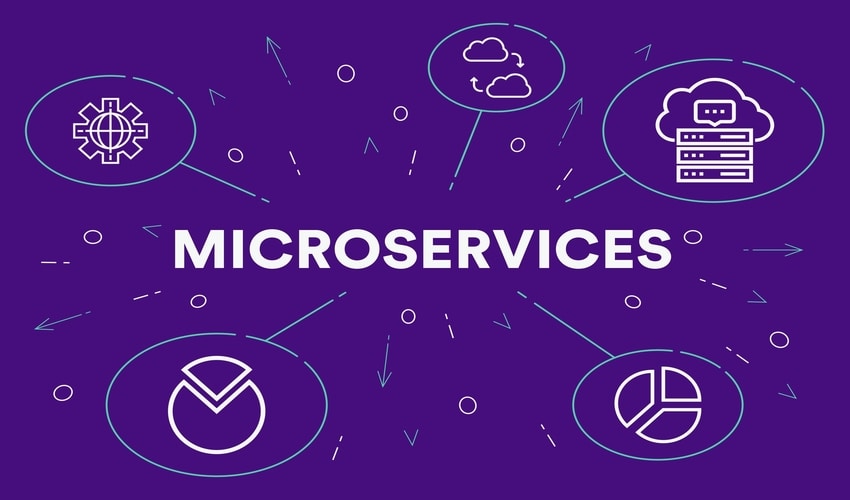Last updated on April 8th, 2024 at 06:51 am
Microservices is an architecture pattern that is becoming increasingly popular nowadays. The pattern is used in development wherein a large application is built as a combination of smaller services that work cohesively together for seamless functionality. This software development approach focuses on disintegrating an application into multiple single-function modules with neatly-outlined interfaces.
Instead of large teams working on complex, monolithic apps, smaller and more agile teams can be used to develop the services using frameworks they are most comfortable with. Every single program is individually versioned, implemented, and scaled. These microservices then interact with one another to shape a fully functional and resourceful application.
A lot of developers claim that microservices architecture is a great way to streamline the infrastructure. Instead of a monolithic architecture, using microservices offers flexibility, sustainability, and ease of integration. Besides, implementing this architecture pattern with a foundation laid of best practices can immensely improve your software architecture. You can get in touch with a reputed Web App Development Company that can ensure a seamless transition to the microservices architecture.
In this article, we will look at the numerous benefits of microservices along with a few code examples and the best practices. So let’s get started.
Benefits of Microservices
If the migration from a monolithic architecture to the microservices pattern is done in the right way, it can offer tremendous benefits to the developers.
- Easier process adoption: Implementing microservices architecture makes the adoption of new technology and the entire process much easier.
- Single-function modules: Since a large application is decomposed into various single service units, it becomes easier for the developers to develop and maintain it.
- Independent scaling: Every single module in the microservices architecture can be scaled independently. The X-axis scaling is done by cloning with additional memory whereas the Z-axis scaling is done by size using sharding.
- DURS: DURS stands for Deployed, Updated, Replaced, & Scaled. With a microservices architecture, every single service can be individually DURS.
- Unaffected: In case of an unfortunate event where one of the modules stops working, the remaining parts of the application will not be affected.
Making the most of microservices is an important step that involves deep knowledge. Below are some of the microservices best practices as well as design principles that will enable you to build single service units that deliver optimum value.
Microservices Best Practices
By now, you should be able to tell that implementing a microservices architecture for web apps comes with a long list of benefits for development and operations. They result in improved scalability, better reliability, and cost savings. However, it is important to note that microservices also come with their fair share of pitfalls.
Below are some best practices that will help to promote seamless migration.
- Have a separate data store for each of your microservice
You are simply defeating the purpose of implementing microservices if you are using a monolithic database. Any downtime to the database will adversely impact all microservices that use it. So, make sure to use an exclusive database for each microservice and customize it to suit the data it maintains. And in case another microservice requires access to that data, it must be through the APIs.
- Use asynchronous communication and events to attain loose coupling
This is an important technique to avoid the build-up of extremely tightly coupled components. So make sure to use asynchronous communication to make calls to your dependencies. Alternatively, the microservices can communicate via events. For instance, one microservice would create and publish an event to a message bus that lists a state change or a failure. Now, whichever microservice is interested in the aforementioned event would simply pick it up and process it.
- Pass the microservice needs through an API gateway
Rather than having every single microservice perform the tasks of API request, authentication, throttling, etc. making an API gateway handle all that will add immense value to the app. This way, whichever client calls your microservice will automatically connect to the API gateway, saving you several additional calls. Besides, the internal URLs of your service will be concealed, enabling you to redirect traffic from the API to the latest version of your service. This is especially helpful when a third-party is accessing your service as you can regulate all the inward traffic and cast-off illicit requests from the API gateway before they reach your microservice.
- Have a dedicated infrastructure to host your microservice
A bad design of the hosting platform can make your microservice perform rather poorly. You must isolate your microservice infrastructure from all the other components to make sure it performs at its best. Also, isolate the infrastructure of all the other components that your microservice relies on.
- Containerize your microservices
Microservices and containers often go pretty well together. When you have containerized your microservices, you can easily manage and deploy different services independently, sans affecting the services hosted on other containers. This is extremely important as it offers complete platform independence and ease of interoperability.
- Use a centralized logging and monitoring system
This ensures that all microservices transfer their logs in a homogeneous format but save them discreetly. This is an effective system as it promotes quicker error management and root cause analysis. Besides, having a centralized monitoring system makes it easy to identify the compromised resources early on.
- Consider security susceptibilities within the microservice architecture
It is advisable to opt for the DevSecOps model as it certifies a secured framework. In general, microservices are much more prone to attacks and hacks owing to the distributed structure. So, when security is concerned, you need to go for a completely different approach as opposed to a monolithic framework. And this is why DevSecOps is the ideal choice.
Wrapping Up
The fact that microservices help to manage complex applications better cannot be overemphasized. However, the transition to microservices architecture can be pretty daunting. The approach of implementing this architecture may vary but these aforementioned best practices are universal.
If you meticulously follow these practices, you will be able to achieve a framework that is distributed, loosely coupled, and independent while instituting a DevOps model that facilitates automation and productivity.

James Grills is currently associated with Cumulations Technologies, one of the leading Flutter Application development services providers. He is a technical writer with a passion for writing on emerging technologies in mobile application development and IoT technology.




